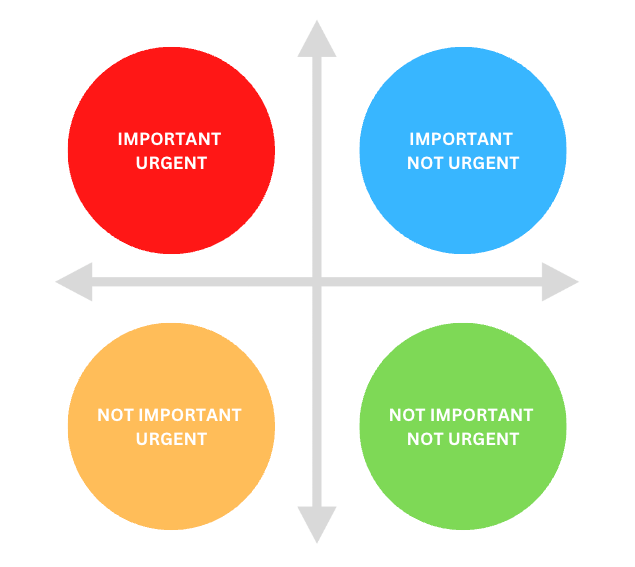Ever made a business decision that came back to bite you? It seemed right at the time, but in the cold light of day it’s proven to be unfortunate at best – disastrous at worst. When you’re tasked with the responsibility of making the right choices for your team, there’s a lot at stake and a lot of room for error. This article explores the factors behind poor business decision making, how it can impact your team, and the steps you can take to make better business decisions.

A quick Google search will tell you that you make 35,000 decisions every day. However, just because everyone’s doing it doesn’t mean it’s easy. According to studies, managers at a typical Fortune 500 company collectively waste more than 500,000 days a year on ineffective decision making. That’s a staggering amount of time lost on the fundamentals of running a business.
Before diving into what causes this ineffective decision making, it’s important to know what we mean when referring to “business decisions” — and what those decisions might look like.
The 3 Types of Business Decisions Managers Have to Make

Business decisions define business operations, goals and future activities. They can be divided into three main categories: strategic, tactical and operational business decisions.
Strategic Decisions
Strategic business decisions define the high-level direction of a business. Although this type of business decision doesn’t take place very often, they can often have huge consequences. As such, they will generally need approval from a board of directors. These types of decisions are only made after careful analysis and evaluation of data. Decisions like deciding to launch a new product or launching an existing product in a new market sit under this category.
Tactical Decisions
Tactical business decisions are taken more frequently than strategic decisions. As a result, they are usually delegated to department heads and senior managers. Tactical business decisions exist because of strategic decisions: usually to define targets in line with a greater objective. Tactical decisions could include changing the pricing structure for your product or service, distributing budgets across departments, or restructuring teams.
Operational Decisions
Operational business decisions happen on a daily basis at a lower management or team level. They are straightforward, routine and (individually) low-risk. Promoting employees, allocating marketing spend and developing new sales initiatives are all operational decisions.
Understanding the impact your decision will have and weighing up your options carefully is vital to making the right business decisions. Even if you have the skills and experience to make these decisions, you still won’t get it right all of the time. There are plenty of challenges which can throw you off track and lead to less than desirable outcomes.
What Happens When You Make Poor Business Decisions?

The poet William Blake hit the nail on the head with his observation that “hindsight is a wonderful thing, but foresight is better.” Blake knew that there’s nothing worse than the sinking realization of having made the wrong decision. Beyond that, the knock-on effect of bad decisions can be huge. Here’s how poor decision making negatively impacts your team:
You Create Chaos and Confusion

Companies need leaders who make good choices. Poor strategic business decisions can occur when there is a lack of clarity around the company mission, vision and values. Worryingly, a study by Gallup indicates that only 22% of employees feel that leaders have a clear direction for the organization.
When high-level strategic decisions aren’t informed by a shared direction, chaos ensues. Confusion around what, why and how things should be done trickles down through the organization and leads to more poor decision making. This is because strategic decisions set the tone for the tactical and operational decisions taken by department heads and managers. Bad strategic business decisions lead to bad tactical decisions and…you get the picture.
Say you’re a strategic decision maker in a tech company and you decide to launch a new product: “We want to make self-driving cars by 2025.” However, you’ve underestimated how much research and time is required to make that happen, so your timeline is unrealistic. Your tactical decision makers are scrambling to make it possible, but this takes their focus away from existing products that actually make you money. It’s not clear how they should be allocating resources – time, budget, people – which makes it impossible to plan. As a result:
- Your team struggles to prioritize tasks and projects, which causes delays.
- Your team wastes time on duplicate work and mistakes become more frequent.
- There is a conflict of priorities across teams, with department heads battling it out for resources. This creates an unpleasant atmosphere which can stifle collaboration.
Your Growth Slows Down (Or Stops Completely)

A survey conducted by McKinsey revealed that “respondents at the few companies that excel at decision making report the ability to perform well […] while also seeing better financial results”. The study also found that “quality and speed of decision making are both strongly associated with overall company performance.” To look at it another way: making slow, poor-quality decisions – particularly at a strategic level – has a negative impact on business growth.
Bad investments and bad decisions are a sure-fire way to slow your growth or stop it completely. You might have to make budget cuts, which can include letting employees go. With fewer available resources, your product or services can decline, which leads to unhappy customers, followed by a further drop in revenue and growth. Once you’re in this cycle, it’s difficult to break out of it.
Poor business growth can also affect your team at a more granular level. When growth declines:
- Focus is taken away from long-term strategic work. This leads to reactive decision-making, which can further contribute to poor alignment across the company. A lack of clear direction creates an environment where poor decision making becomes the rule rather than the exception.
- Your team members experience “burnout”. Apart from taking a toll on your team’s health, burnout can contribute to decision fatigue – and so the quality of decisions made deteriorates. People experiencing burnout are prone to procrastination, impulsivity, risky behavior, avoidance, and indecision. Simply put, burnout perpetuates the poor business decision making cycle.
- Employee turnover skyrockets. When your company isn’t doing well, employees don’t feel secure in their jobs and they start looking elsewhere. Those who resign take their company-specific knowledge with them, leaving a gap that might not be filled for months. This puts your business at a disadvantage because the decisions that need to be made are uninformed.
Your Team’s Morale Drops

On average, you’ll work 90,000 hours over the course of your lifetime. When business decisions take away or create confusion around the purpose and meaning of the work your team is doing, engagement and morale drop significantly. Poor communication, a lack of recognition and poor business performance can also influence your team’s morale – all of which can arise from poor decision making.
When team morale drops, conflict arises. This conflict creates a hostile working environment where decision making can become personal, rather than objective.
Why Do You Make Poor Decisions? The Steps You Can Take To Make Better Business Decisions.

Nobody sets out to make bad decisions. Sometimes it can be difficult to pinpoint exactly where it all went wrong. Understanding the factors behind poor business decision making can help you recognize where you’re getting caught out and take the necessary steps to get back on track.
Reason #1: Missing or Incorrect Information

You can’t make decisions without the correct information. This might include the resources available for a certain project, or the level of knowledge your team has to execute it. It also extends to the quantitative data you’re basing your decisions on. Missing, old or inaccurate data (also called “bad data”) will lead to false assumptions that send you down the wrong path. Bad data is “any piece of information that is wrong, misleading, or confusing in its format”. The consequences of using bad data for decision making are manifold. It can lead to an incorrect and unsuccessful business strategy, a damaged reputation, an increase in costs, and numerous missed opportunities for development and growth.
Solution #1: Gather and Centralize Information
Commence share some practical tips for improving your data quality to better inform your decision making process. To summarize:
- Find the source of bad data. Make sure your source is accurate and your data extraction techniques are correct.
- Refine your data collection process. Ask yourself whether you’re collecting the data you actually need. Finetune your process by having third parties review the information after collection and compilation.
- Regularly audit your database. All the information you have should be properly collected, processed, and managed – especially as your business grows.
When you have good data, whether quantitative or qualitative, it needs to be properly documented. Studies show that on average, employees spend 9.3 hours per week searching for information. That’s almost a quarter of the working week. Tools for sharing and centralizing documents let you quickly access the information you need to make better business decisions.
With the right data at hand, it’s easier to spot gaps in your knowledge and know which questions to ask. Additionally, knowing where to look for guidelines, processes and other contextual information will prevent any major panic when you have to make an informed decision quickly.
Reason #2: Time Pressure

Working under time pressure can lead to a “scarcity mindset” which is when you believe (rightly or wrongly) that resources are limited. As a result, your ability to think analytically is reduced, and you turn to short-term coping mechanisms rather than long-term problem solving. For example, you might sign off on work which is wrong or incomplete, just to get it off your desk.
Time pressure has been shown to “bias judgments toward already known information and away from externally provided information.” This means that although you might have access to the information you need to make the right decision, you base your decisions on less helpful – or even incorrect – information because it is more convenient. If you’re under pressure, you’re also more likely to focus on negative information to make your decision. This tendency skews your decision making process and results in unexpected negative outcomes.
Solution #2: Prioritize
When faced with a decision, you may encounter an obstacle you couldn’t have foreseen – a global pandemic, for instance – which means you have to come up with an alternative solution quickly. Either way, prioritizing now will save you time in the long run.
The Eisenhower Matrix is a simple decision-making tool which helps you make better business decisions. It’s made up of four categories into which you can divide your tasks and projects:
- Important and urgent: Focus on this first.
- Important, but not urgent: Schedule time to work on this and set a deadline.
- Not important, but urgent: Delegate this to a less senior team member.
- Neither important nor urgent: Don’t spend another second thinking about this!
Eisenhower’s urgent vs. important principle can seem contradictory at first glance. The question “How can something be urgent and yet not important?” is a reasonable one.
Important but not urgent tasks lead directly to you achieving your goals. They usually take longer to complete than urgent tasks, and don’t require a resolution right this second. Important but not urgent tasks could include implementing a tool to centralize documentation and improve information sharing within your team.
Urgent but not important tasks usually take you away from your priorities and contribute to achieving someone else’s goals. It can be tempting to do these tasks anyway because “ticking them off the list” provides instant gratification. Urgent but not important tasks might include client phone calls, team meetings, or requests for “quick” input or feedback from colleagues.

Reason #3: Poor Planning

“A failure to plan is a plan to fail”, or so the saying goes. Planning ahead keeps your team’s focus on a shared goal and allows for strategic decision making instead of reactive damage control.
At a strategic level, poor planning can be far-reaching. At a tactical level, it can lead to project delays, work that misses the mark, spiraling costs, and a loss of trust from customers, clients or employees. Even at an operational level, a failure to plan can result in rash decisions and errors, which accumulate over time.
Solution #3: Consider Your Options With a Decision Tree
Overwhelmed with options? Narrow them down by using practical techniques such as mind mapping. You can build out a decision tree to answer questions such as “Should I delegate this task”, “Should I involve my team in this decision now” or “Should this be a meeting”? This will help keep your decision making consistent until it becomes a habit.
Take the decision tree example below. The main question “Should I delegate this task?” is at the top. Below that is the obvious question you need to ask first: “Could someone else do this task?” If no, you’ll want to think about teaching someone else how to do it – it’s not great for the business if only one person can carry out an important task. If someone else can do the task, simply progress along the tree until you reach the right business decision.
When you create your own decision trees in MindMeister, start with your “big” question at the top, and map out the following questions you need to ask in a logical order. Thinking step by step will help you find the most practical solution depending on the situation.
Solution #3b: Consider Your Options With a Decision Matrix
Alternatively, a decision matrix is a useful tool when you have to decide between more than one option, and there are several factors which influence your decision. Using a decision matrix allows you to compare different solutions to a single problem, factoring in variables that are important to your decision. It can also help you “prioritize tasks, solve problems and craft arguments to defend a decision you’ve already made”. It’s a great way to remove emotion and bias from the decision making process and evaluate potential solutions in a logical way.
For example, you might be deciding which agency to hire for your brand refresh:
- In your decision matrix, score each agency between 1-5 for each variable. Say Agency 1 delivers the best quality, so they get a 5. Agency 3 only gets a 3, and so on.
- Next, add weight to each criteria based on the relevance to the decision. For example, if cost is the most important consideration, give it a 5.
- Now multiply the weight of each category with the rating you gave every option in that category.
- Add up all the points and a winner should emerge.
Use a decision matrix template to reach the right decision faster.
Solution #4: Plan Your Projects
It’s obvious, but often ignored: project planning means good results. Your team will:
- Work cohesively to achieve the project goal.
- Understand how projects fit into team workflows.
- Evaluate the impact your project will have on other teams and identify ways it can support other areas of the business.
- Allocate resources correctly.
- Set expectations and establish realistic deadlines for delivery.
Try using a mind map to plan your next project. Mind maps are visual, which makes them perfect for displaying the information needed to make better business decisions.
It helps me to visualize each worksite with the responsible employees – and it’s easier to allocate the right resources as a result.
Reason #4: Stress

When your team is stressed, they might feel unable to choose one way or the other. This doesn’t bode well for good business decision making. Similarly, studies have shown that anxiety disrupts the decision making process and leads to poor choices.
Solution #5: Support Your Team
Mindful leadership can reduce stress and have a positive impact on your team’s mental health. Professors Megan Reitz and Michael Chaskalson explore mindful leadership through the lens of AIM. AIM refers to the capacities teams need to support healthy working relationships, resilience, and better collective decision making. It stands for
Allowing: Cultivating an attitude of acceptance and kindness towards ourselves and others.
Inquiry: A curiosity about what is happening and the ability to think critically about it.
Meta-awareness: Observing thoughts, feelings and impulses as they happen and acknowledging the ability to change our behavior.
What might this look like in practice on a day-to-day level? If a team member seems stressed or upset, ask them if they’re feeling okay. Take the first few minutes of every meeting to ask how everyone’s day is going. If someone says something you disagree with, take a moment to pause and reflect before responding. Although these steps won’t directly prevent poor decision making, they lay the groundwork for an environment which supports everyone to make better business decisions. And, if you end up making the wrong decision (you’re only human), your team is more likely to weather the storm.
Reason #5: Siloed Thinking & Consensus-Driven Culture

Working in silos means information doesn’t flow freely between teams, and team members are left wondering who is working on what. This lack of transparency can cause you to make decisions without all the facts. Likewise, you also lack the diversity of perspectives needed to make informed business decisions.
A consensus-driven culture creates the same problems. Where teams are over-rewarded for being positive and receptive, team members are less inclined to ask questions or push back in fear of rocking the boat. This can lead to comfortable decisions – rather than the right decisions – being made.
Solution #6: Invite Input From Others

Inviting other perspectives highlights solutions you might not have even considered. It also leads to more critical thinking around a problem, which helps you to make better business decisions. Mind mapping tools can help generate these discussions with your team.
For a successful brainstorming session:
- Generate as many ideas as possible
- Don’t criticize anyone’s ideas at this stage – your own included!
- Embrace wild and unusual ideas
- Combine and improve on each other’s ideas
Unlimited numbers of people can work simultaneously on one mind map, which results in a noticeable increase of quality in the ideas that are generated.
Solution #7: Embrace Feedback
If you’ve made the wrong decision, doubling down only makes things worse. When it comes to feedback from your team, listen carefully and be open to the possibility they might be right. Feedback from others close to the problem, or who will be affected by the decision you make, is invaluable. Don’t wait for them to come to you. Hold a focused meeting to gather input and invite team members to add their feedback into a shared mind map. This gives you insight to inform your decision making in future, and your team will feel heard.
You can use the “How Might We” template to gather feedback around a central problem or area for improvement. Encourage your team to ideate solutions, narrow them down together, vote on the ones they like best, and select the ideas with the most votes.
Reason #6: Failure To Adapt

Just because it’s always been done this way, doesn’t mean it always should be. Failure to make adjustments based on new information can lead to decisions being made based on a reality that doesn’t exist. Being able to adapt is essential if you want to make better business decisions.
Solution #8: Analyze Using SWOT and PESTLE
PESTLE and SWOT help you to understand decision context. From there, you can analyze problems objectively. The PESTLE model invites you to research and note the political, economic, social, technological, legal and environmental factors related to the problem you are solving. The SWOT model invites you to look a little closer to home. It provides a structure for you to analyze the strengths, weaknesses, opportunities and threats of and to your business.
Reason #7: Conflict and Interpersonal Issues.

Good conflict is when you have different or opposing views based on different perspectives and experiences. It’s what makes life interesting, and it encourages critical thought, engagement and problem-solving. However, bad conflict can negatively influence business decision making. When there’s a shift from “let’s tackle the problem together” to “you are the problem”, decisions become personal rather than objective. Conflict also causes team members to avoid contributing or speaking up when they identify problems. As a result, the discussion and debate necessary for making informed business decisions is lacking.
Solution #9: Address Conflict in a Controlled Environment
When conflict arises, approach discussions sensitively – and come prepared. Focusing on specific examples and avoiding generalizations will keep the discussion objective. It’s helpful to create an action plan for resolving the conflict that all parties can agree on, and follow up to ensure the steps towards resolution have been taken.
To reduce the risk of “bad” conflict within your team, consider introducing nonviolent communication. Nonviolent communication involves deep listening, empathy and compassion. There are lots of NVC teachers out there who offer training sessions for teams. These are designed to help participants develop conflict-management and communication skills. With objectivity and empathy, you can challenge biases, break reactive habits, and make better business decisions.
Solution #10: Build a Healthy Workplace Culture
Your business culture has a big impact on how you make decisions and whether they’re successful. Peter Ashworth, CEO of Humanity We, summed it well when he wrote: “A healthy culture leads to less internal politics, a flatter and more efficient decision-making processes, and fewer disagreements”. As recent events have shown, business growth shouldn’t come at the expense of a healthy business culture. Neglecting your culture limits success in the long-run as it feeds into many of the factors that prevent you from making better business decisions.
A healthy workplace culture promotes:
Belonging. A 2019 study conducted by BetterUp Inc. indicated that a perception of “belonging” at a company was linked to a 56% increase in job performance, a 50% drop in turnover risk and a 75% reduction in sick days. You can improve belonging by celebrating individuality and providing equal opportunities to try new things or take on more responsibility.
Contribution. Being able to contribute creates a sense of purpose and leads to higher employee engagement and satisfaction. Delegate tasks and ask for your team members’ input when it allows them to demonstrate or improve their skills.
Flexibility. Flexibility means the freedom and autonomy to decide (to an extent) when and how work gets done. Make sure team members have what they need to manage their own time and priorities – then trust them to do so.
Equity. To be equitable, a company must recognize that we don’t all have the same level of privilege – and make adjustments to “correct” imbalances.
Growth. A growth mindset encourages employees to share knowledge, experience and skills for their own personal and professional development. Motivate your team by setting clear targets, and assigning KPIs to teams and individuals to encourage accountability.
The Time To Make Better Business Decisions Is Now.

There are so many reasons for bad business decision making, and even more ways it can impact your team. The consequences often feed back into each other, causing a cycle of confusion, poor results, low team morale, and even more bad decisions.
This is why it can feel so challenging to move past poor decisions and make better ones. But it’s not impossible. Taking the steps outlined here should guide you to take control of the decision making process and to work together with your team in a way that supports transparent, informed and healthy decision making.
FAQs
What Types of Business Decisions Do Managers Have to Make?
Business decisions can be divided into three main categories: strategic, tactical and operational business decisions. Strategic business decisions define the high-level direction of a business, whereas tactical business decisions define targets in line with a greater objective. Operational business decisions are routine and (individually) low risk.
What Happens When You Make Bad Business Decisions?
Poor business decisions can affect your team in many ways. It creates chaos and confusion, which leads to difficulties prioritizing and planning. It can also slow or stop your growth completely. Making the wrong decisions can damage your team’s morale and create conflict – all of which feeds into a cycle of poor decision making.
What Causes Poor Business Decision Making?
A number of factors can cause you to make poor business decisions. These include missing or incorrect information, time pressure, poor planning and stress, to name just a few. There are steps you can take to overcome these challenges in order to make better business decisions.

